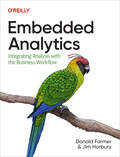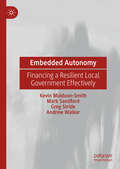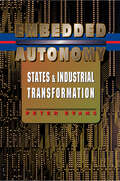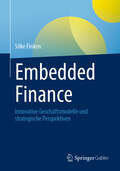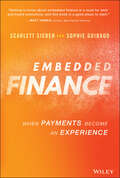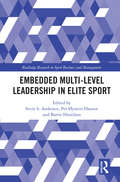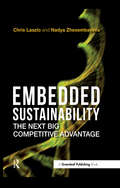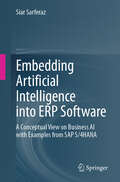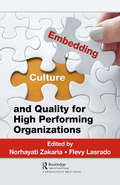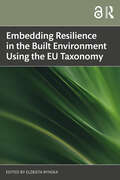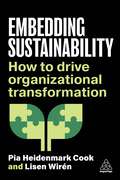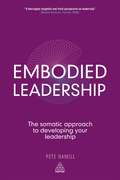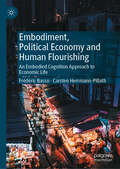- Table View
- List View
Embassy To The Eastern Courts: America's Secret First Pivot Toward Asia, 1832-37
by Andrew C. JampolerIn the aftermath of the Napoleonic Wars, the U. S. found its merchants and traders locked out of their traditional markets in Europe and the Caribbean. Hoping for new and profitable American trade relationships, President Andrew Jackson dispatched an unemployed ship-owner and merchant with no diplomatic experience on a secret mission to negotiate with Eastern potentates in their courts. Edmund Roberts’ mission was to formalize American trade with these exotic places--Oman, Siam, Cochin China, and Japan--on a most favored nation basis, allowing for American consuls to openly advance and protect American interests and citizens in their host country. After sailing almost 70,000 miles in five years in the ill-fated USS Peacock, Roberts was successful in negotiating treaties with Oman and Siam, but he failed in Cochin China, and he died before setting sail to Japan. Peacock, first flagship of the Navy’s new East Indies Squadron, forerunner of the U. S. Seventh Fleet, outlived him by only a few years.
Embed Analytics in Business Processes: A How-To Guide
by Thomas H. Davenport Jeanne G. Harris Robert MorisonIf you really want to put analytics to work in your organization, you need to make them an integral part of everyday business decisions and business processes. A cross-functional process perspective enables you to appreciate how different parts of the business work together (or fail miserably in doing so) and to identify all the ways analytics might be used to create a better outcome for the enterprise. In this chapter, the authors of Competing on Analytics guide you through embedding analytics into every aspect of your business. They outline the ideal characteristics of analytically enabled business processes, the three fundamental approaches to determining how automated your analytically enabled decisions should be, IT's role in embedding analytics into business processes, and how to overcome sticking points to embedding analytics in your company's day-to-day operations. This chapter was originally published as Chapter 7 of Analytics at Work: Smarter Decisions, Better Results.
Embedded Analytics: Integrating Analysis with the Business Workflow
by Donald Farmer Jim HorburyOver the past 10 years, data analytics and data visualization have become essential components of an enterprise information strategy. And yet, the adoption of data analytics has remained remarkably static, reaching no more than 30% of potential users. This book explores the most important techniques for taking that adoption further: embedding analytics into the workflow of our everyday operations.Authors Donald Farmer and Jim Horbury show business users how to improve decision making without becoming analytics specialists. You'll explore different techniques for exchanging data, insights, and events between analytics platforms and hosting applications. You'll also examine issues including data governance and regulatory compliance and learn best practices for deploying and managing embedded analytics at scale.Learn how data analytics improves business decision making and performanceExplore advantages and disadvantages of different embedded analytics platformsDevelop a strategy for embedded analytics in an organization or productDefine the architecture of an embedded solutionSelect vendors, platforms, and tools to implement your architecture Hire or train developers and architects to build the embedded solutions you needUnderstand how embedded analytics interacts with traditional analytics
Embedded Autonomy: Financing a Resilient Local Government Effectively
by Andrew Walker Kevin Muldoon-Smith Mark Sandford Greg StrideThis book addresses the sustained failure to properly fund local government in England. While there has been plenty of rhetoric and policy initiatives around devolution of power to local authorities in recent decades, continuing recently with the English Devolution Bill, there has been far less attention paid to how these endeavours will be practically delivered and, most importantly, funded. In this context, the motivation in this book is to consider how local government in England could be funded differently. How can the continual hand to mouth existence of local authorities, and those that work to support them, be improved? Drawing on a system-based analysis of international local government practice, the authors develop a new theory of embedded autonomy to help understand and frame how local government can be funded effectively in England.
Embedded Autonomy: States and Industrial Transformation
by Peter B. EvansIn recent years, debate on the state's economic role has too often devolved into diatribes against intervention. Peter Evans questions such simplistic views, offering a new vision of why state involvement works in some cases and produces disasters in others. To illustrate, he looks at how state agencies, local entrepreneurs, and transnational corporations shaped the emergence of computer industries in Brazil, India, and Korea during the seventies and eighties. Evans starts with the idea that states vary in the way they are organized and tied to society. In some nations, like Zaire, the state is predatory, ruthlessly extracting and providing nothing of value in return. In others, like Korea, it is developmental, promoting industrial transformation. In still others, like Brazil and India, it is in between, sometimes helping, sometimes hindering. Evans's years of comparative research on the successes and failures of state involvement in the process of industrialization have here been crafted into a persuasive and entertaining work, which demonstrates that successful state action requires an understanding of its own limits, a realistic relationship to the global economy, and the combination of coherent internal organization and close links to society that Evans called "embedded autonomy."
Embedded Finance: Innovative Geschäftsmodelle und strategische Perspektiven
by Silke FinkenDieses Buch gibt einen Überblick über Treiber und Hintergründe der Entwicklung von Embedded Finance und zeigt konkrete strategische Perspektiven speziell für Finanzdienstleistungsunternehmen und ihre Firmenkunden auf sowie alle Unternehmen, die von der Integration von Finanzdienstleistungen in ihre Customer Journeys profitieren können. Die Integration von Finanzdienstleistungen wie Zahlungen, Finanzierungen und Versicherungen in die Produkte und Angebote von Unternehmen und Lifestyle-Apps wird immer mehr zur Normalität. Getrieben wird dies durch ein Zusammenspiel von technologischen Entwicklungen, Veränderungen von Kundenerwartungen und -verhalten und regulatorischen Initiativen. Für Unternehmen eröffnet Embedded Finance die Möglichkeit, durch eine nahtlosere Integration von Finanzdienstleistungen ihre Customer Journeys zu optimieren. Für Finanzdienstleister ergeben sich Chancen zu einer intensiveren Entwicklung von neuen Angeboten gemeinsam mit ihren Kunden. Andererseits entstehen auch signifikante geschäftspolitische Herausforderungen, die eine strategische Gesamtperspektive auf das Thema erfordern.
Embedded Finance: When Payments Become An Experience
by Scarlett Sieber Sophie GuibaudEmbedded finance is here and having global impact. Are you ready for it? In Embedded Finance: When Payments Become An Experience, veteran growth strategists, entrepreneurs, and fintech disruptors Scarlett Sieber and Sophie Guibaud deliver a thought-provoking and page-turning discussion on the most impactful and exciting trend of fintech yet: embedded finance. In the book, you’ll explore the past, present, and future of fintech, from how embedded finance is being leveraged today by industry heavyweights like Google and Amazon to supercharge their customers’ experience to the offerings of smaller, niche players who stand poised to dominate their own corners of the market as their answer unmet customers’ needs. The authors present: ● Practical examples around the world of how embedded finance is being used today by technology companies and brands to redefine our online and offline retail experiences as we know them ● The key trends, players, and technologies that are paving the way for embedded finance to take a dominant position in our lives ● The role, opportunities, and strategies for banks, technology companies and brands, providing them with all necessary tools to define their own embedded finance strategy ● The impact of embedded finance on society, consumers, companies, and the economy as a whole, highlighting the dominant force that is embedded finance for our future ● An exciting view of how our day-to-day lives will look like in 2030, powered by embedded finance An indispensable and eye-opening exploration of one of the most exciting and influential technologies in development today, Embedded Finance details a revolution in financial services, banking, and technology that has already begun. Are you ready?
Embedded Multi-Level Leadership in Elite Sport (Routledge Research in Sport Business and Management)
by Barrie Houlihan Svein S. Andersen Per Øystein HansenThis book represents an alternative perspective on international elite sport systems. It focusses on the embedded multi-level nature of leadership, and the scope that this might give for degrees of leadership autonomy and discretion. The chapters show how mechanisms of leadership on different levels interact. The nature and mix of leadership mechanisms reflect values and expectations related to specific political, normative and commercial sport contexts. Three introductory chapters outline key elements of these dimensions of elite sport contexts. Seven empirical cases illustrate how national contexts facilitate and constrain leadership practices, related to specific sports across Russia, China, Ghana, Germany, Switzerland, Denmark, Norway and the US. The final chapter discusses embedded multi-level leadership from a comparative perspective. Based on the countries covered, the book distinguishes between three groups: state-dominated systems, state-elite sport partnership and countries with a passive state, with no state intervention. This book is important reading for researchers and students with an interest in sport management, sport development, sport policy and sport governance, as well as for policy-makers, performance directors and managers working in elite sport.
Embedded Politics: Industrial Networks and Institutional Change in Postcommunism
by Gerald A. McdermottEmbedded Politics offers a unique framework for analyzing the impact of past industrial networks on the way postcommunist societies build new institutions to govern the restructuring of their economies. Drawing on a detailed analysis of communist Czechoslovakia and contemporary Czech industries and banks, Gerald A. McDermott argues that restructuring is best advanced through the creation of deliberative or participatory forms of governance that encourages public and private actors to share information and take risks. Further, he contends that institutional and organizational changes are intertwined and that experimental processes are shaped by how governments delegate power to local public and private actors and monitor them. Using comparative case analysis of several manufacturing sectors, Embedded Politics accounts for change and continuity in the formation of new economic governance institutions in the Czech Republic. It analytically links the macropolitics of state policy with the micropolitics of industrial restructuring. Thus the book advances an alternative approach for the comparative study of institutional change and industrial adjustment. As a historical and contemporary analysis of Czech firms and public institutions, this book will command the attention of students of postcommunist reforms, privatization, and political-economic transitions in general. But also given its interdisciplinary approach and detailed empirical analysis of policy-making and firm behavior, Embedded Politics is a must read for scholars of politics, economics, sociology, political economy, business organization, and public policy.
Embedded Sustainability: The Next Big Competitive Advantage
by Nadya Zhexembayeva Chris LaszloCompanies know how to meet the demands of shareholder value: years of managerial excellence testify to this achievement. Many also know how to create stakeholder value – through traditional approaches such as CSR and philanthropy which predictably lead to trade-offs and added costs. What remains elusive is discovering is how to meet both shareholder and stakeholder requirements in the core business – without mediocrity and without compromise – creating value for the company that cannot be disentangled from the value it creates for society and the environment. What if sustainability was embedded into the DNA of your organization? How can you incorporate environmental, health and social value into its very core? Many companies, despite their best intentions, "bolt on" sustainability as an afterthought to their core strategies. They trumpet green initiatives and social philanthropy which lie at the margins of the business, with symbolic wins that inadvertently highlight the unsustainability of the rest of their activities. Today's ecological and social pressures require a different business response – one that existing strategy frameworks fail adequately to address. In Embedded Sustainability, authors Chris Laszlo and Nadya Zhexembayeva explain and predict how companies can better leverage global challenges for enduring profit and sustained growth. They introduce the marquis concept of embedded sustainability: the incorporation of environmental, health, and social value into the heartbeat of the product life-cycle with no trade-off in price or quality – no social or green premium. This book helps readers to comprehend and implement the notion of embedded sustainability. At its best, embedded sustainability is invisible, similar to quality. In addition to delivering socially and environmentally conscious products for consumers, it is capable of considerably motivating employees. Most of all, it enables smart companies to create even more value for both their shareholders and stakeholders.
Embedding Artificial Intelligence into ERP Software: A Conceptual View on Business AI with Examples from SAP S/4HANA
by Siar SarferazThis book explains how to embed artificial intelligence in digitized business processes of ERP software by solving the two related substantial challenges: how can artificial intelligence be systematically integrated into ERP business processes for ease of consumption, and how can artificial intelligence be made enterprise-ready by covering ERP qualities like compliance, lifecycle management, extensibility, or scalability? As a general introduction, the first part of this book takes the reader through a historical journey towards intelligent ERP systems. In addition, reference processes and a reference architecture for ERP systems are proposed which build the foundation for the suggested subsequent solution concept, including a method for operationalizing intelligence for ERP business processes. Subsequently, in the second part detailed concepts of embedding artificial intelligence into ERP software are proposed. In this context the suggested solution architecture is depicted, and specific topics are resolved like data integration, model validation, explainability, data protection and privacy, model degradation and performance. In the last part an implementation framework is suggested which enables the previously introduced concepts and harmonizes the development and operations of artificial intelligent ERP applications. This part concludes with case studies considering artificial intelligence scenarios of SAP S/4HANA in the areas of logistics, finance and sales which apply the defined solution approach and shows its real-world feasibility. This book is written for professionals who want to implement (as developers) or exploit (as business analysts or consultants) or consider/plan the implementation/exploitation (as managers) of artificial intelligence in business information systems.
Embedding CSR into Corporate Culture
by Diane L. SwansonEmbedding CSR into Corporate Culture demonstrates that a new frontier for corporate social responsibility is possible in theory and practice. The key idea - discovery leadership - enables corporate managers to deal effectively with problems, issues, and value clashes occurring at the corporation-society interface.
Embedding Culture and Quality for High Performing Organizations
by Norhayati Zakaria Flevy LasradoEmbedding Culture and Quality for High Performing Organizations (978-1-138-48338-5, K349105) Shelving Guide: The aim of this book is to bridge two different core disciplines: quality management and cross-cultural management, based on how multinational corporations work, and how culture determines individual practices and values. Understanding these previously separate fields is essential to keeping multinational cultures innovative and sustainable. The authors’ research blends corporate and cultural perspectives to promote quality management practices that build organizational excellence. Whereas most books currently on the market are based on corporate culture and quality management, this book uniquely considers cross-cultural impacts on organizational effectiveness and global human resource management. This book provides opportunities for business practitioners and researchers to learn practices that are effective in building sustainable organizational excellence. It offers a practice guide to building a quality management program that emphasizes culturally-diverse work environments, cross-cultural management, and organizational excellence.
Embedding Resilience in the Built Environment Using the EU Taxonomy
by Elzbieta RynskaTaxonomy is the common name for an EU regulation that supports companies in sustainable environmental and climate action (Regulation [EU] No. 2020/852). It is a classification tool designed for investors, companies, and financial institutions to define the environmental impact of business activities and the requirements that organisations must meet to be considered as sustainable.The aim of this book is to examine the EU taxonomy from the built environment perspective and the ways in which it can be used to build resilience in real estate. It presents the issues, hot points, and possible choices from the designers, construction consultants, and investing bodies' points of view, those who must set forth initial conditions, which should later become the keystones for greener developments. It brings together the expertise of a unique team of both researchers and professionals and presents a methodology, case studies, and solutions which together comprise a novel understanding of the taxonomy’s influence on the pre-construction phase. The book:• describes the role of the built environment within sustainable development and how real estate can be used to build resilience with the use of taxonomy.• describes the characteristics of resilient environmentally friendly cities in the future.• proposes a roadmap to demonstrate urban policies that promote decarbonisation; and•enables investors to compare their products, operations, and strategies in terms of sustainability.Overall, this book is essential reading for decision-makers in the public and private sectors, urban developers, space and spatial designers, architects, planners, community stakeholders, and real estate investors.Chapter 1 of this book is freely available as a downloadable Open Access PDF at http://www.taylorfrancis.com under a Creative Commons Attribution-Non Commercial-No Derivatives (CC-BY-NC-ND) 4.0 license.
Embedding Space in African Society: The United Nations Sustainable Development Goals 2030 Supported by Space Applications (Southern Space Studies)
by Annette FroehlichThis book provides a detailed insight into how space and its applications are embedded, and can be further embedded, into African society in support of the SDGs, while taking into account the specific features, needs, and diversity of that society.Contributions drawn from across the continent and further afield provide analyses of the particular social situations in a variety of different African countries and regions, and highlight areas where space applications support the SDGs, and where they can further do so. The chapters cover a wide array of relevant and timely topics including basic needs like water quality, education, and capacity building, as well as financial, security, and legal aspects, together with facets of space technologies and infrastructure in Africa. Embedding Space in African Society will be of great interest to students and professionals in sustainable development, governance, and space studies.
Embedding Sustainability: How to Drive Organizational Transformation
by Pia Heidenmark Cook Lisen WirénEmbedding Sustainability is a practical, solutions-focused guide for sustainability managers and leaders to embed sustainability in organizations and drive improved performance.For organizations to truly embody sustainability, it must infuse all operations. Sustainability change agents need to be the conductors of the orchestra, making sure everyone has the same objective, is working with the same goals and is moving at the same pace. Embedding Sustainability charts the journey from purpose, scope and assessment to strategy, implementation and integration. It outlines the steps required to engage and commit employees to deliver to the same goals, creating a workplace where success is achieved through collective effort.Drawing on impressive experience, the authors share valuable tools and tips, lessons and coaching, factoring in different organizational maturity levels, international contexts and cultural differences and stakeholder mapping.It explores leadership principles, values, culture, strategies and engagement methods. Embedding Sustainability provides mid-senior sustainability professionals with guidance and encouragement to continue with their work and avoid common mistakes, while also prioritizing their own wellbeing. It will help sustainability change agents navigate the unique challenges of this role, find solutions to problems and maintain a positive outlook.
Embedding the Core Competence Perspective: Competing for the Future
by Gary Hamel C. K. PrahaladA company must be viewed not only as a portfolio of products or services, but a portfolio of competencies as well. This chapter outlines five key competence management tasks that the entire management team must fully understand and participate in for the core competence perspective to take root in an organization.
Embezzlement and High Treason Louis XIV's France: The Trial of Nicolas Fouquet
by Vincent J. PittsA look at life in the court of King Louis XIV, the politics of the time, and the trial of a man who knew too much for his own good.From 1661 to 1664, France was mesmerized by the arrest and trial of Nicolas Fouquet, the country’s superintendent of finance. Prosecuted on trumped-up charges of embezzlement, mismanagement of funds, and high treason, Fouquet managed to exonerate himself from all the major charges over the course of three long years, in the process embarrassing and infuriating Louis XIV. The young king overturned the court’s decision and sentenced Fouquet to lifelong imprisonment in a remote fortress in the Alps.A dramatic critique of absolute monarchy in pre-revolutionary France, Embezzlement and High Treason in Louis XIV’s France tells the gripping tale of an overly ambitious man who rose rapidly in the state hierarchy—then overreached. Vincent J. Pitts uses the trial as a lens through which to explore the inner workings of the court of Louis XIV, who rightly feared that Fouquet would expose the tawdry financial dealings of the king’s late mentor and prime minister, Cardinal Mazarin.“A compelling account of a political drama in mid-seventeenth century France, but it is also a window into the process by which rule of law gradually became established . . . [and] I thoroughly enjoyed reading it.” —EH.Net“Pitts’s book examines the show trial of Fouquet, and…the political process that created such an unfair outcome for a man who is often seen as one of the most well-known scapegoats in French history. Pitts has succeeded masterfully in weaving a powerful narrative that exposes convoluted corruption and mismanagement of ancient régime France.” —Renaissance Quarterly
Embezzlement and High Treason in Louis XIV's France: The Trial of Nicolas Fouquet
by Vincent J. PittsLouis XIV’s vendetta against his disgraced finance minister exposed dark truths about the state's finances.From 1661 to 1664, France was mesmerized by the arrest and trial of Nicolas Fouquet, the country’s superintendent of finance. Prosecuted on trumped-up charges of embezzlement, mismanagement of funds, and high treason, Fouquet managed to exonerate himself from all of the major charges over the course of three long years, in the process embarrassing and infuriating Louis XIV. The young king overturned the court’s decision and sentenced Fouquet to lifelong imprisonment in a remote fortress in the Alps.A dramatic critique of absolute monarchy in pre-revolutionary France, Embezzlement and High Treason in Louis XIV's France tells the gripping tale of an overly ambitious man who rose rapidly in the state hierarchy—then overreached. Vincent J. Pitts uses the trial as a lens through which to explore the inner workings of the court of Louis XIV, who rightly feared that Fouquet would expose the tawdry financial dealings of the king's late mentor and prime minister, Cardinal Mazarin.
Embodied Design in Innovation und Kommunikation: Durch erlebensbezogenes Denken neue Handlungsräume entdecken – Theorie und Praxis
by Judith PapadopoulosDieses Buch beschreibt einen neuen Gestaltungsansatz für Organisationen, der körperlich-emotionale Einflüsse in Innovationsprozessen und in der Kommunikation berücksichtigt, und vermittelt das Zusammenspiel von Körper und Kognition wissenschaftlich und praxisorientiert zugleich. Alles, was wir tun und erleben, hat mit unserem Körper zu tun: Wir sprinten in einem Projekt, wir haben ein schlechtes Bauchgefühl, Finanzsysteme machen schlapp und die Politik krankt. Solche Metaphern drücken aus, dass Wahrnehmungen körperliche Erlebensprozesse sind. Diese wiederum haben großen Einfluss auf kognitive und neurologische Vorgänge, die kreatives Denken erst ermöglichen und anstoßen. Und wenn wir dieses erlebensbezogene Denken fördern, entdecken wir folglich neue Handlungsmöglichkeiten. Die Autorin liefert eine fundierte Anleitung für das praktische Vorgehen, um neue Produkte und Dienstleistungen auf mehreren Ebenen wirkungsvoll zu gestalten, Innovationen von Beginn an zu unterstützen und neue Handlungsräume für Kommunikationsstrategien zu finden. Die einzelnen Phasen des Gestaltungsprozesses werden anschaulich beschrieben. Dabei fließen aktuelle wissenschaftliche Erkenntnisse aus der Kognitionslinguistik ein, und erprobte Methoden, Hilfsmittel und Anwendungsbeispiele von Embodied Design werden vorgestellt.Ein Buch für Geschäftsführer, Innovationsverantwortliche, Change-Manager, Marketing- und Vertriebsexperten, Organisationskommunikatoren sowie interessierte Studierende, die neue Wege beschreiten wollen.
Embodied Leadership
by Pete HamillWe don't need leaders who know about leadership - we need leaders who embody the capacity to lead in the midst of ambiguity and complexity. The concept of embodied leadership is derived from somatic coaching, a unique approach that brings the body forward as an advocate in creating a place for change and transformation. It brings together language, action, feeling and meaning and is based on the idea that the mind and body are inextricably linked: to develop one, you must cultivate the other. Embodied Leadership deconstructs our thinking about the body using key discoveries in neuroscience to demonstrate the uses and benefits of a somatic approach, particularity in the area of emotional intelligence.There are practical exercises throughout to develop embodied leadership skills and personal development.
Embodied Time: Temporal Cues in Built Spaces
by Kevin NuteThe word time occurs more than seven times as often as space in written English, yet in the design of the indoor environments where we now spend most of our lives these priorities are typically reversed, with time often being little more than an afterthought. Embodied Time endeavors to correct that imbalance by demonstrating how built environments can be designed to evoke positive recollections of the past, interactions with the present, and anticipations of the future.
Embodiment and Professional Education: Body, Practice, Pedagogy (Debating Higher Education: Philosophical Perspectives #8)
by Stephen Loftus Elizabeth Anne KinsellaThis book draws attention to the ways in which an awareness of, and sensitivity to, embodiment can enlighten educational practices. It explores discourses from a range of thinkers, including Merleau-Ponty, Gadamer, Bakhtin, Haraway and Ahmed to name a few. The book argues that attention to embodiment can help us to reimagine the goals of education in ways that fit more coherently with human concerns and that offer the chance to provide education that is more holistic and grounded in our corporeality. Theories of embodiment can be used to modify education at the level of curriculum and at the level of pedagogy. This can help us design educational interventions that fit more naturally with how humans are inclined to learn and thus make educational experiences more meaningful. Attention to embodiment allows us to appreciate the extent to which the body appropriates a professional practice and the extent to which a professional practice appropriates the body of the learner. It shows how greater sensitivity to the body can enliven and enlighten our educational practices, especially in professional education.
Embodiment, Political Economy and Human Flourishing: An Embodied Cognition Approach to Economic Life
by Carsten Herrmann-Pillath Frédéric BassoThis book presents embodied economics as a foundational alternative to behavioral economics and other projects integrating economics and psychology inspired by the computational paradigm. The 20th century witnessed the disembodiment of economic models through the intensification of mathematization and formal abstraction in economics. Even proponents of an embodied approach to cognition, such as Hayek, paradoxically championed the abstract market order as a disembodied superhuman intelligence. In the wake of groundbreaking perspectives in cognitive and social sciences, which have helped to rethink the fundamental building blocks of economics, agency and institutions, this title takes a radical turn towards embodiment. Reinstating economics as political economy, embodied economics motivates a critique of capitalism based on the analysis of disembodiment through abstraction and reactivates key critical insights into the anthropology put forward by the young Marx about contemporary economics and its conceptualizations of money, property, and labor. Based on this analysis, the authors envision a concrete utopia for an economic order centered on human dignity and care for life on Earth. This book contributes to recent discussions about behavioral, experimental and neuroeconomics and addresses a transdisciplinary audience in the social and behavioral sciences, philosophy, and the humanities.
Embodying Exchange: Materiality, Morality and Global Commodity Chains in Andean Commerce (The Human Economy #11)
by Juliane MüllerAddressing the infrastructural, legal and moral complexities in contemporary world trade, this book uses an ethnographic analysis of the interface of multinational brand manufacturers and popular traders in the Bolivian Andes. It offers a situated account of traders’ understanding of regulatory principles, and traces commercial dynamics beyond the limits of what we define as economic. It aims to humanize our understanding of the economy by grounding it in everyday life and morality.


